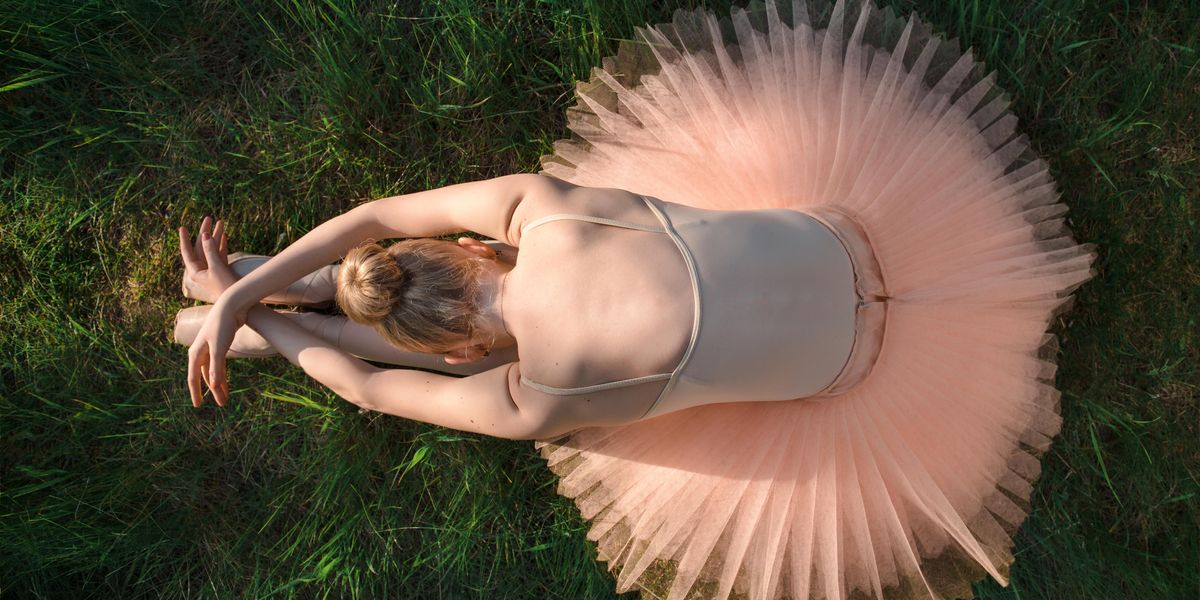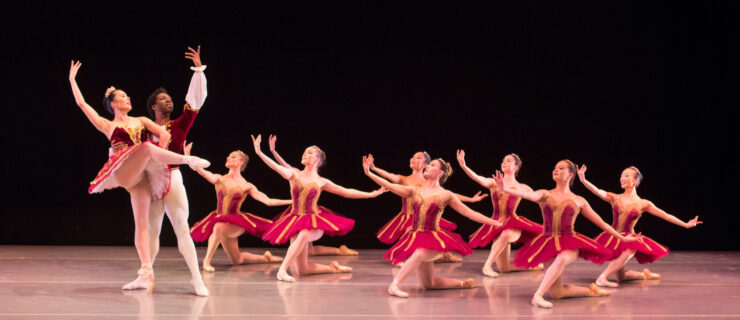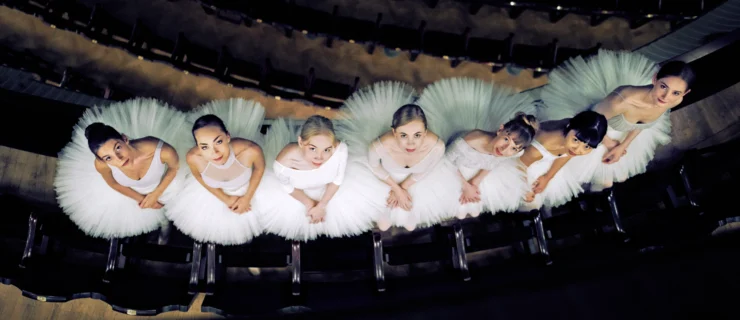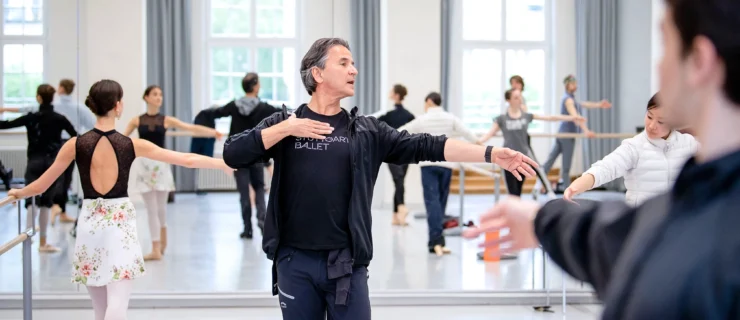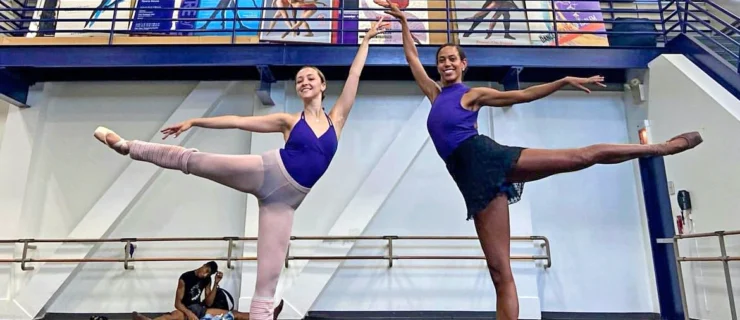Dancing In A New Body
I felt complete horror as I watched my performance on the tape: Like a poorly articulated marionette, my body flopped around the stage, all elbows, bent knees and sickled feet. It was our spring performance at Pittsburgh Ballet Theatre School, and since entering the preprofessional program just 10 months earlier, I’d gained three inches to reach a gangly 5’9”. And despite my best intentions, the movements I thought I was performing were nothing like the images captured on that video.
Many young dancers deal with growth spurts—often during the pivotal years of their preprofessional training. They can leave you feeling like you’re dancing in someone else’s body, unable to control your own limbs. While this can be frustrating, it’s not the end of your technique: There are ways to deal and even improve during a growth spurt.
What’s Happening?
“The biggest thing going on is that the bones are growing faster than the muscles, so your muscles get tight,” says Nadia Sefcovic, DPT, who treats many young dancers at New York City’s Westside Dance Physical Therapy.
The things most noticeably affected are coordination and proprioception, or sense of body position (you know, when you feel like that arabesque is behind you until you look in the mirror to find yourself in the “dog-over-a-hydrant” position?). “During this period the neural system has a difficult time adapting to changes in muscle spindles and joint receptors, due to the new length and tension in the muscles, ligaments and tendons,” says Sefcovic. “Turns and petit allégro are often most difficult.”
How to Deal
The key to surviving a growth spurt is all in your alignment. Instead of beating yourself up because you can’t get that third pirouette, focus on the basics. “Correct placement is the most critical element at this time,” says Janet Popeleski, principal of the student division at Pittsburgh Ballet Theatre School. “This is when students either develop strong technique or start cheating, which can later lead to injuries.”
Sefcovic recommends focusing on keeping your lumbo-pelvic area aligned and finding your balance. She has dancers practice quick tendus and dégagés while keeping the pelvis still, and balance in different positions with the eyes open, then closed. Eliminating your visual field will give you a sense of how your balance might be off. She also recommends working on core strength to improve alignment and find stability.
Be Kind to Yourself
“It’s important to listen to your body—you are at a greater risk for a muscle strain or tear,” says Sefcovic. “Keep stretching and massaging tight muscles.”
Don’t allow frustration to overpower you. As a lanky 14-year-old, I was constantly reduced to tears, feeling like I was standing still while my peers flew past me. Popeleski, who helped motivate me through this trying period, encourages her students to look at the big picture. “If they have a good work ethic they will come around,” she says. “This period is temporary.”
While I can’t erase my awkward rendition of Balanchine’s choreography at PBTS, I did have more articulate performances in my future. I keep that VHS tape because it represents a time in my training when I managed to keep pushing on until I found my way to the other side.
Exercises To Do During a Growth Spurt For pelvic alignment and control of hip external rotation:
- Lie on your back with your knees bent, feet flat on the floor and your abdominals contracted. Allow your right thigh to slowly fall towards the floor, making sure to keep your pelvis straight—don’t let it tip—and flat against the ground. Alternate legs, and repeat for two to three minutes.
- Stand in parallel demi-plié with your feet aligned beneath your hips. Slowly rotate your pelvis and torso towards the left while keeping your right leg stationary, knee aligned over the second toe. Hold this for 10 seconds, then slowly return to the beginning position. Repeat this in the other direction and continue alternating to the right and left, 10 times each.
For coordination:
- Lie on your back with your legs resting against the wall at a 90-degree angle. Bend your knees, sliding your feet down the wall. Make sure to maintain the alignment of your second toe, knee and hip in a straight line. Isolate your toes, flex them and release;then isolate your ankles, flex them and release while continuing to maintain your alignment. After repeating several times, straighten your legs and point your feet without sickling or winging. —Nadia Sefcovic
The Top Five Foods for Growing Dancers
Spinach
“You need to make sure you are getting lots of calcium to promote bone growth and
development,” says Sefcovic. “Leafy greens like spinach are a great source of calcium. It’s not just in dairy products.”
Peanut Butter
Girls tend to gain weight before they start growing. “This doesn’t mean you’re getting fat,” says Peggy Otto Swistak, nutritionist for Pacific Northwest Ballet School. “The body is building up energy to get taller.” If you’re looking to keep your weight in check, Swistak recommends keeping some “healthy fat,” like peanut butter, in your diet to help your body absorb vitamins and lubricate your joints. Healthy fats also help your body produce testosterone, which triggers muscle growth.
Salmon
“The flesh of fish and fish liver oils are good sources of vitamin D and proteins,” says Sefcovic. Vitamin D is needed for the absorption of calcium. Nerves, tissues and bones are all made of proteins, so they are necessary for growth and repair.
Lima Beans
Another great source of protein is lima beans. They also provide fiber, which is important for the digestion process and will help keep your weight in check by making you feel fuller. “Legumes, such as cooked split peas, lentils or black beans, are also good sources of fiber and proteins,” says Sefcovic.
Oranges
Your body is under a lot of stress during a growth spurt. You need vitamin C to combat those stressors and stay healthy. Oranges are a great source, but any citrus fruit will do.
Stay Strong–Even When You Are Broken
Getting your body back into ballet shape after an injury is hard enough, but if one of your limbs has been stuck in a cast, you also have to deal with super-weak muscles surrounding the injured body part. Luckily, you can actually keep those muscles strong by performing resistance training with the opposite limb. It may sound like new-fangled pseudo-science, but this method was actually discovered in1894. Known as the “cross-education effect,” scientists have only recently started to understand how it works. A study at the University of Saskatchewan in Canada found that by working out just your right ankle, for example, you can improve the way in which your nervous system controls muscle activation in both ankles. This won’t build new muscle, but it will help maintain some of the strength in immobile limbs. Don’t go overboard: If you’re trying to keep your left calf strong, you only need to do three sets of 10 relevés on the right leg, two or three times a week.
Beat Bloat
Feeling bloated when you have to perform in nothing more than a leotard and tights can be a complete confidence-buster. Fight the puffiness by upping your calcium intake. Researchers aren’t exactly sure why, but bloating often occurs when calcium levels dip too low. Drink a glass of low fat milk or munch on cheese or yogurt a few hours before curtain.
Try This: Stomach Massage Twist
If you’re looking to develop sky-high développés, focus on strengthening your obliques, the abdominal muscles that run down the sides of your stomach. “The oblique muscles can help distribute some of the work away from overactive quads and allow the side body to pitch in,” says Brooke Siler, owner of Manhattan Pilates studio re:AB. She recommends this exercise:
Sit on your tailbone with your knees bent, toes resting lightly on the mat. Reach your arms up to the ceiling. Exhale as you stretch both legs into a “V” shape and twist your upper body to the right, reaching your right arm toward the back of the room. Inhale as you return to your starting position. Repeat to the left, and complete a total of three to five sets.
